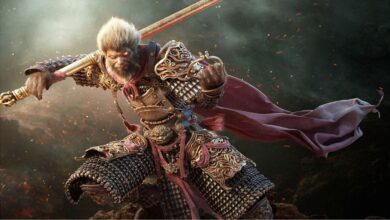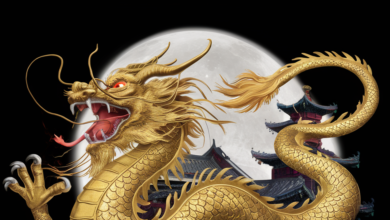
Table of Contents
The tale of «the Cowherd and the Weaver Girl» is a beloved ancient love story among the Han Chinese, ranking as one of the Four Great Folktales of China, alongside «The Legend of Liang Shanbo and Zhu Yingtai,» «Meng Jiangnu’s Tears at the Great Wall,» and «The Legend of the White Snake.» Its origins lie in the celestial bodies known as the Cowherd Star and the Weaver Girl Star, which have been passed down through generations as symbols of enduring love and longing.
There are several versions of the story, each with its own unique twists and interpretations, which I’ll detail below.
Most Renowned Edition
Cowherd followed his mean brother and sister-in-law in their daily life, but he was kind-hearted and took great care of the family’s old cow. One day, the old cow suddenly spoke: «Tomorrow, go to the lake on the other side of the mountain. You will meet a group of celestial maidens bathing in the river. Hide a red feathered robe. The celestial maiden who loses her robe will become your wife.»
Following the advice, Cowherd did as instructed. Indeed, he encountered a celestial maiden, known as the Weaving Maiden, who couldn’t fly back to heaven because she lost her robe. Impressed by Cowherd’s kindness, she married him. They had a son and a daughter, and lived happily together. Unfortunately, the old cow passed away. Before dying, it instructed Cowherd to skin it and use the hide in case of emergency.
Upon hearing of her daughter’s marriage to a mortal, the Heavenly Queen Mother sent celestial soldiers to take the Weaving Maiden away. Cowherd, wearing the cowhide, placed his children in two bamboo baskets and flew away as his house collapsed.
As they approached the Weaving Maiden, the Heavenly Queen Mother created a wide river, the Milky Way, separating them. Unable to cross, the couple could only gaze at each other from opposite sides. Over time, they became the stars Altair and Vega on either side of the Milky Way. Every year, on the seventh day of the seventh lunar month, a flock of magpies would form a bridge across the Milky Way, allowing Cowherd and the Weaving Maiden to reunite on this special day.
The story of Cowherd and the Weaving Maiden, along with «The Legend of the White Snake,» «The Butterfly Lovers,» and «Meng Jiangnv Cries at the Great Wall,» are considered the Four Great Chinese Folktales, with origins dating back to the Eastern Han Dynasty.
Apart from the version of a young couple’s love thwarted by feudal authority, there have been various versions of this tale over the centuries. These versions reflect the major contradictions and cultural characteristics of Chinese society at different times.

Over-Worked and Penalized Edition
Once upon a time, during the era of the Northern and Southern Dynasties in ancient China, there lived a hardworking maiden named Yin Yun, known as the Weaving Maiden, daughter of the Heavenly Emperor. Each year, she tirelessly worked at her loom, weaving clouds and celestial garments, her appearance unkempt from her labor.
Feeling sorry for her solitary existence, the Heavenly Emperor decided to find her a companion. He arranged for her to marry a young cowherd from the western side of the Milky Way. However, after their marriage, the Weaving Maiden neglected her weaving duties, much to the Emperor’s dismay.
Angered by her negligence, the Heavenly Emperor punished her by sending her back to the eastern side of the river, separating her from her husband. They were allowed to meet only once a year.
This tale, though not solely a love story, also carries a lesson about balancing marital responsibilities with societal duties, highlighting the importance of managing both personal and social obligations in harmony.
Ghost a Loan Edition
In this version, also appearing during the Northern and Southern Dynasties era, Cowherd marries the Weaving Maiden but fails to return the twenty thousand coins borrowed from the Heavenly Emperor as a dowry. After a prolonged period of non-payment, he is forced to work as a laborer.
Cowherd, a poor young man, borrowed twenty thousand coins from the Heavenly Emperor to marry the Weaving Maiden. Whether it was a loan or embezzlement is not detailed, but the fact remains that he couldn’t repay it. Consequently, he was punished with hard labor. The outcome of this marriage was undoubtedly the separation of the couple.
This version of the story doesn’t depict love but rather the price of marriage, satirically criticizing the custom of hefty dowries in Chinese society since the Han Dynasty. Historical records show extravagant dowries for emperors and nobles, leading to inflation in the dowry demands for commoners. The tradition of exorbitant dowries, as depicted in this tale, often led to financial burdens and desperate measures for impoverished individuals like Cowherd, ultimately resulting in their punishment.
Adultery Edition
In the «Adultery Version,» chronicled in the «Taiping Guangji» during the Tang Dynasty, the Weaving Maiden, unable to endure her solitude, descends to the mortal realm and propositions a man named Guo Han.
One evening, Guo Han, a handsome youth from Taiyuan, reclined in the courtyard when a strikingly beautiful woman descended from the heavens. Identifying herself as the Weaving Maiden from celestial realms, she confessed to her prolonged loneliness without a romantic partner. She elaborated that the Heavenly Emperor had granted her permission to descend to Earth. Expressing admiration for Guo Han’s character, the Weaving Maiden proposed a union, to which they mutually consented, culminating in an intimate encounter. Subsequently, the Weaving Maiden visited Guo Han nightly, and they developed a profound attachment.
Curious about the reaction of her nominal husband, Cowherd, to their liaison, Guo Han inquired. Boldly, the Weaving Maiden asserted that the Milky Way served as a barrier, rendering Cowherd ignorant of their affair; she remained undaunted even if he were aware. On the occasion of the Qixi Festival (Chinese Valentine’s Day), the Weaving Maiden briefly absented herself to address matters with Cowherd before resuming her clandestine rendezvous with Guo Han. Following a year of clandestine romance, the Weaving Maiden abruptly bid farewell, and they shared a tearful parting, exchanging keepsakes. Subsequently, Guo Han and the Weaving Maiden corresponded briefly, but her disappearance left him afflicted with lovesickness. Despite his subsequent marriage and attempts to perpetuate his lineage, his union proved unhappy, devoid of progeny.
This rendition underscores the liberal attitudes prevailing in Tang Dynasty society, where women enjoyed elevated status, epitomized by the sole female monarch in Chinese history, Empress Wu Zetian. Here, the Weaving Maiden dismissed Cowherd with indifference, indicative of the marital autonomy enjoyed by Tang women. Notably, the practice of princesses contracting multiple marriages was commonplace during this era, a departure from earlier traditions. Ji Xiaolan, recounting Guo Han’s liaison with the Weaving Maiden in the «Yuewei Caotang Biji» during the Qing Dynasty, derided it as «extremely absurd,» highlighting the stark contrast in ideological perspectives between the two dynasties. This rendition emerged solely during the Tang Dynasty and subsequently vanished.
Marital Strife Edition
Scholars Qu Yude and Hong Shulian have collected two different versions of the Cowherd and the Weaving Maiden legend, where the husband and wife’s relationship turns sour.
In the version popular in the Suyang area of Jiangsu Province, it’s the Weaving Maiden who becomes discontented. In this telling, the saying «Life is tough for a poor couple» rings true. After their marriage, Cowherd, worn down from hard labor, becomes thin and dark. Feeling he no longer matches her status, the Weaving Maiden decides to return to her parents’ home. When Cowherd catches up to her, she tears off her silver hairpin and draws a silver river in the sky, severing their marital ties.
In the version from Shulu in Hebei Province, it’s Cowherd who initiates the split. After marrying into the Heavenly Court, he struggles to adapt to celestial life and frequently clashes with the Weaving Maiden. Their arguments escalate into physical altercations, with both hurling objects at each other, drawing the attention of the Queen Mother. Despite her attempts to mediate, the Queen Mother eventually separates them by drawing the Milky Way with her golden hairpin, forcing the couple to live on opposite sides of the river.
One depicts a wealthy woman struggling with poverty, while the other portrays a social-climber failing to adjust after marrying into a wealthier family. Yet, in both versions, their marriage ends in separation. These renditions depict the Weaving Maiden not as a lofty celestial being, but rather as a relatable woman with her own personality and temperament.
On 7th July of chinese calendar, commonly known as «Qixi,» is said to be the day when the Cowherd and the Weaver Girl meet on the «Magpie Bridge» once a year. For thousands of years, this ancient and touching love story has been passed down through generations. This day is also acclaimed by modern people as the Chinese version of «Valentine’s Day.

Click on the link for more Chinese Traditional Legends:


